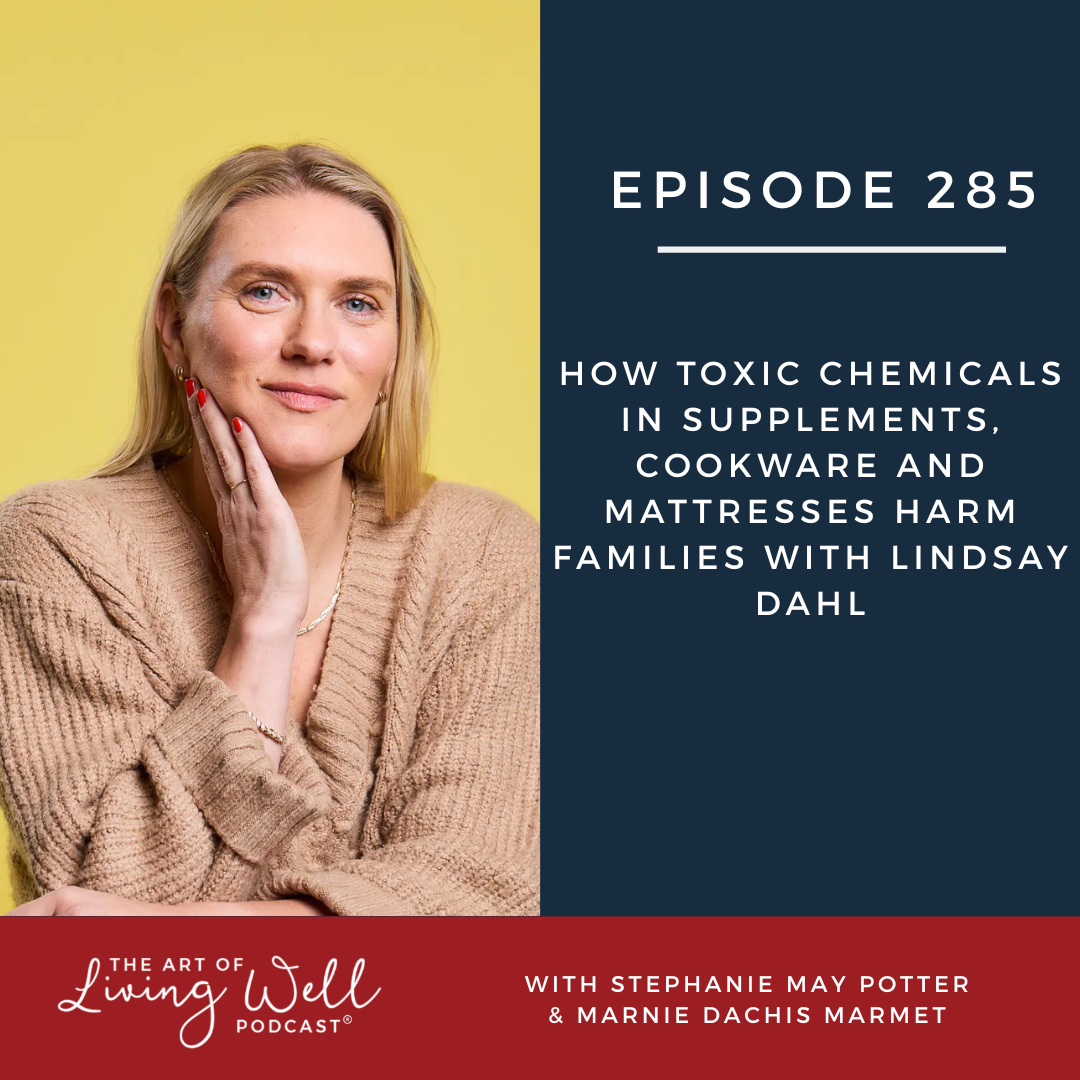E285: How Toxic Chemicals in Supplements, Cookware and Mattresses Harm Families with Lindsay Dahl
What Are Toxic Chemicals Doing Inside Our Homes
In today’s world, people are paying closer attention to the safety of everyday products. More families want to know what goes into the products they use each day, from cookware to cosmetics. At the same time, confusion has grown.
Some believe the risks are exaggerated, while others feel urgent action is overdue. This divide has made the topic of toxic chemicals both important and personal, because it directly touches the health of our homes and families.
Lindsay Dahl has spent over 20 years working on this very issue. She is the Chief Impact Officer at Ritual, leading sustainability, advocacy, and consumer health efforts.
Before joining Ritual, she helped shape national reforms at Beautycounter, pushing for safer beauty standards. She also played a key role in passing U.S. chemical and cosmetic safety laws updates.
Beyond her work with companies, Lindsay serves on the board of Toxic-Free Future and partners with groups like NRDC and Breast Cancer Prevention Partners.
She is also the author of Cleaning House: The Fight to Rid Our Homes of Toxic Chemicals, a book blends science, policy, and real-life advice.
In this article, we will look at why Lindsay wrote her book, the challenges she faced, and the lessons she shares. We will also explore the most common household products that may contain harmful chemicals and simple steps to reduce exposure.
Finally, we will learn how personal choices and collective action can create healthier homes and stronger protections for everyone.
Why Did Lindsay Dahl Write Cleaning House to Address Toxic Chemicals
Lindsay Dahl wrote Cleaning House: The Fight to Rid Our Homes of Toxic Chemicals because she saw a growing divide.
She worked on environmental health and consumer safety for over twenty years. Science has long shown that many chemicals act like synthetic hormones and harm people.
Photo by Lisa from on Pexels
Yet during the pandemic, social media split the public into two camps. Some dismissed the issue as fear tactics, while others fought for safer products. Dahl realized this confusion called for a clear and balanced guide.
Why It Matters
Dahl shows that toxic chemicals are not only an environmental concern. They affect daily life inside every home. She explains two key points:
Decades of research link chemicals to serious health risks.
Weak laws still allow unsafe products to enter the market.
By sharing science and her personal experience, Dahl helps readers see the bigger picture. Safer homes and stronger rules go hand in hand. Cleaning House guides people to understand the risks, make better choices, and push for change that protects families everywhere.
What Toxic Chemicals Should We Focus on First
You cannot remove every chemical from your home; trying to do so will only cause stress. The best approach is to focus on the biggest sources of exposure. Four product categories matter the most.
Photo by on Shot on Pexels
Supplements
Many supplements, especially those made from plants, can contain heavy metals from soil. You will not find products that are completely free of them, but you can choose safer ones.
Look for certifications like Clean Label Project, which test for more than 200 contaminants and confirm safer sourcing.
Cookware
Nonstick pans often contain fluorinated compounds, also called “forever chemicals.” These stay in the body and the environment. Safer choices include:
Stainless steel – durable, safe, and easy to cook with
Cast iron – affordable and long-lasting, though it needs some care
Ceramic-coated pans are an option, but their coatings wear down quickly and add waste.
Furniture and Mattresses
Couches, chairs, and mattresses are often treated with flame retardants or stain-resistant sprays. These coatings may seem helpful, but they usually contain toxic chemicals.
Choose items labeled free from PFAS and flame retardants. Avoid those promoted as stain-resistant for couches, since this often means chemical treatments.
Personal Care and Beauty
Products that sit on the skin all day matter most. Lotions, creams, and makeup are at a higher risk than shampoo or conditioner, which rinse away. Safer choices include:
EWG Verified products
Made Safe Certified products
Options from Credo, a retailer with strong clean standards
Keep It Practical
This is not about being perfect. Focus on the categories that make the greatest difference. Small swaps, like safer cookware or lotion, can lower daily exposure and create a healthier home.
How Can We Create Real Change on Toxic Chemicals?
Trying to live a toxin-free life often feels impossible. The truth is, you do not need to aim for perfection. Chasing extremes only creates stress and makes most people give up. The better way is to focus on balance and push for change where it counts most.
Photo by August de Richelieu on Pexels
Shift the Burden
Families should not carry the entire weight of keeping homes safe. We should not need endless shopping lists or label guides. The real responsibility belongs to companies and the chemical industry.
They must produce safer products before they reach store shelves. Stronger laws are the only way to make that happen, and lawmakers respond when people demand it.
Simple Actions That Matter for Reducing Toxic Chemicals
You do not need huge resources to play a role. A few small steps go far:
Support credible nonprofits. Groups like NRDC and Breast Cancer Prevention Partners share clear science and track laws.
Contact officials. Many nonprofits provide ready-to-send letters. You add your name and zip code, and it takes seconds.
Choose reliable sources. Avoid relying only on social media. It often spreads confusion. Instead, follow organizations that explain science in simple terms.
Proof That Change Works
Change takes time, but it is possible. Asbestos was finally banned in 2023. Cosmetic safety laws were also updated after decades of delay. These wins show that progress happens even in a divided political climate when enough people speak up.
Building Stronger Communities
Lasting progress also depends on human connection. Real conversations with family, friends, and neighbors matter more than online debates. Listening to one another and focusing on shared concerns builds unity.
When communities stand together, their voice is stronger and harder to ignore. By combining personal steps with civic action and stronger ties, meaningful change becomes possible.
How Can We Move Forward with Balance and Action on Toxic Chemicals
Aiming for perfection in living a toxin-free life does more harm than good. It creates stress and guilt, and often leads people to give up. Real change comes from balance, perspective, and steady action.
Photo by Anastasiya Gepp on Pexels
Shifting Perspective
Social media often drives extremes. People unfollow or dismiss others for one disagreement, missing the chance to learn. This “all or nothing” mindset makes conversations harder and progress slower.
A better way is to listen, talk in person, and accept that most issues hold nuance. Building trust through real connection allows us to find the middle ground we all need.
Simple Actions That Help
The path forward is not about doing everything. It is about choosing what matters most. You can:
Follow trusted nonprofits like NRDC, Breast Cancer Prevention Partners, or Toxic Free Future. They provide clear science and quick ways to act.
Support companies working toward safer products. Each purchase signals demand for higher standards.
Limit time on social media. Treat it as a tool for sharing, not endless scrolling. The less time online, the more energy you gain for family, friends, and real learning.
The Art of Living Well While Reducing Toxic Chemicals
Living well is not about strict rules. It is about trade-offs and perspective. Being late one morning or slipping into a small habit does not erase progress.
What matters is focusing on the bigger goal: long-term health, balance, and connection. Giving yourself grace makes it easier to reset and return to what truly matters.
When we stop chasing extremes, we reduce stress. When we take small steps, we create impact. And when we value human connection over online noise, we build stronger communities. That is how meaningful change happens.
Conclusion
In conclusion, the journey to safer homes does not require perfection. What matters most is balance and steady action. Lindsay Dahl’s work shows that small steps, like choosing safer cookware or cleaner beauty products, can reduce daily risks.
These choices protect health while also communicating to companies that safety matters. However, families cannot carry this work alone. Companies and lawmakers must share the responsibility.
Stronger rules and better oversight are needed so that harmful products do not reach store shelves in the first place. This shift lets people focus on living rather than worrying about hidden risks.
That said, real change also grows from community action. When people talk with friends and neighbors, awareness spreads. When enough voices call for stronger standards, leaders act. Progress may take time, but history proves it is possible.
The issue of toxic chemicals touches every home. Each choice, each conversation, and each act of support builds momentum.
By focusing on what matters most and standing together, we can create healthier spaces for ourselves and future generations. Balance, awareness, and connection are the tools that lead us forward.
FAQs
What are toxic chemicals in everyday products?
Toxic chemicals can harm health when we come into contact with them. They often appear in cookware, furniture, beauty products, and supplements.
Why do companies still use toxic chemicals in products?
Many companies use them because they are cheap, long-lasting, or effective for certain functions. Weak regulations also allow unsafe substances to stay on the market.
Can toxic chemicals affect children differently from adults?
Children are often more at risk because their bodies are still developing. Even small exposures can have lasting health effects.
Are natural or organic products always free from toxic chemicals?
Not always. Some natural products may still contain harmful substances. Checking for trusted certifications is the safest way to choose.
How do toxic chemicals enter the human body?
They can enter through the air we breathe, food we eat, water we drink, or products we apply to our skin.





